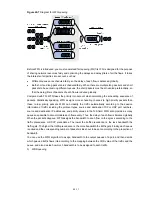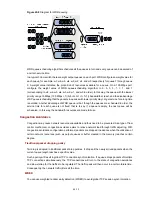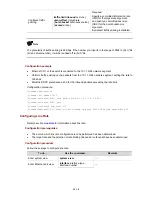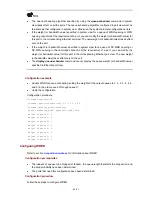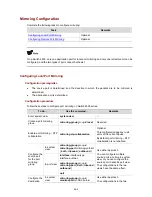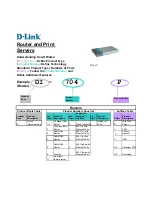
To do…
Use the command…
Remarks
Enter system view
system-view
—
Mark the priorities for the
|
outbound
}
acl-rule
{ {
dscp
packets belonging to a VLAN
traffic-priority vlan
vlan-id
{
inbound
dscp-value
|
ip-precedence
{
pre-value
|
from-cos
} } |
cos
{
pre-value
|
from-ipprec
} |
Required
Refer to the command
manual for information
about the
acl-rule
and matching specific ACL
rules
local-precedence
pre-value
}*
argument.
Configuration example
.1.1/24 network segment.
ce as 56 for the packets from the 10.1.1.1/24 network segment.
1) Method
I
[Sysname] acl number 2000
[Sysname-acl-basic-2000] rule permit source 10.1.1.0 0.0.0.255
[Sysname-acl-basic-2000] quit
[
Et
[Sysname-Ethernet1/0/1] traffic-priority inbound ip-group 2000 dscp 56
2) Method
II
<Sysname> system-view
[
mber 2
[
acl-basic-200
0
[Sysname-acl-basic-2000] quit
[Sysname] traffic-priority vlan 2 inbound ip-group 200
Configuring Traffic Policing
tion
Traffic Policing
z
Ethernet 1/0/1 belongs to VLAN 2 and is connected to the 10.1
z
Mark the DSCP preceden
<Sysname> system-view
Sysname] interface
hernet1/0/1
Sysname] acl nu
Sysname-
000
0] rule permit source 10.1.1.0 .0.0.255
0 dscp 56
Refer to sec
for information about traffic policing.
C
z
d. Refer to the ACL
module of this
manual for information about defining ACL rules.
z
The rate limit for traffic policing, and the actions for the packets exceeding the rate limit have been
C
i
onfiguration prerequisites
The ACL rules used for traffic classification have been define
determined.
z
The ports that need this configuration have been determined.
onf guration procedure
Follow these steps to configure traffic policing:
Remarks
To do…
Use the command…
Enter system view
system-view
—
Enter Ethernet port
inter
view
interface-number
—
face
interface-type
45-17









